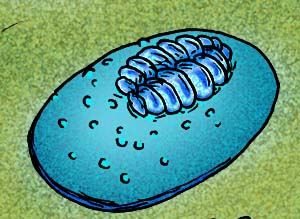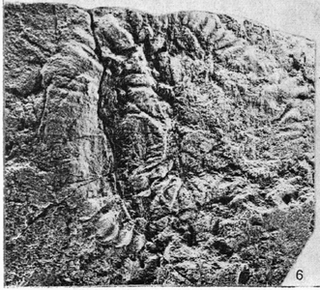
Dickinsonia is a genus of extinct organism that lived during the late Ediacaran period in what is now Australia, China, Russia and Ukraine, most likely a basal animal. It is one of the best known members of the Ediacaran biota. The individual Dickinsonia typically resembles a bilaterally symmetrical ribbed oval. Its affinities are presently unknown; its mode of growth has been considered consistent with a stem-group bilaterian affinity, though various other affinities have been proposed. The discovery of cholesterol molecules in fossils of Dickinsonia lends support to the idea that Dickinsonia was an animal, though these results have been questioned.

Ausia fenestrata is a curious Ediacaran period fossil represented by only one specimen 5 cm long from the Nama Group, a Vendian to Cambrian group of stratigraphic sequences deposited in the Nama foreland basin in central and southern Namibia. It has similarity to Burykhia from Ediacaran (Vendian) siliciclastic sediments exposed on the Syuzma River of Arkhangelsk Oblast, northwest Russia. This fossil is of the form of an elongate bag-like sandstone cast tapering to a cone on one end. The surface of the fossil is covered with oval depressions ("windows") regularly spaced over the surface in the manner of concentric/parallel rows. The taxonomic identity of Ausia is unresolved.

Tribrachidium heraldicum is a tri-radially symmetric fossil animal that lived in the late Ediacaran (Vendian) seas. In life, it was hemispherical in form. T. heraldicum is the best known member of the extinct group Trilobozoa.

Yorgia waggoneri is a discoid Ediacaran organism. It has a low, segmented body consisting of a short wide "head", no appendages, and a long body region, reaching a maximum length of 25 cm (9.8 in). It is classified within the extinct animal phylum Proarticulata.

Cephalonega stepanovi is a fossil organism from Ediacaran deposits of the Arkhangelsk Region, Russia. It was described by Mikhail A. Fedonkin in 1976

Vendia is a genus of oval-shaped, Ediacaran fossils ranging from 4.5 to 12.5 mm long. The body is completely segmented into isomers, which are arranged alternately in two rows longitudinal to the axis of the body. The larger isomers cover the smaller ones externally but the posterior ends of all the isomers remain free. The transverse elements decrease in size from anterior to posterior and are all inclined in the same direction.

Academician Mikhail Aleksandrovich Fedonkin is a Russian paleontologist specializing in documentation of the earliest animals' body fossils, tracks, and trails. He has also described numerous Vendian-aged fossils including Hiemalora, Cephalonega, and Nimbia occlusa.

Bomakellia kelleri is a species of poorly understood Ediacaran fossil organism represented by only one specimen discovered in the Ust'-Pinega Formation of the Syuzma River from rocks dated 555 million years old. Bomakellia was originally interpreted as an early Arthropod. A study by B. M. Waggoner even concluded that the organism was a primitive anomalocarid and erroneously identified the ridges of supposed Cephalon as being eyes making Bomakellia the oldest known animal with vision. But this hypothesis has not reached acceptance, nor acknowledgement.

Ovatoscutum concentricum is one of many enigmatic organisms known from the Ediacaran deposits of the Flinders Ranges, Australia, and the White Sea area in Russia, dating around 555 Ma.

Albumares brunsae is a tri-radially symmetrical fossil animal that lived in the late Ediacaran seafloor. It is a member of the extinct group Trilobozoa.
Anfesta stankovskii is a tri-radially symmetrical fossil animal that lived in the late Ediacaran (Vendian) seafloor. It is a member of the extinct group Trilobozoa.

Proarticulata is a proposed phylum of extinct, bilaterally symmetrical animals known from fossils found in the Ediacaran (Vendian) marine deposits, and dates to approximately 567 to 550 million years ago. The name comes from the Greek προ = "before" and Articulata, i.e. prior to animals with true segmentation such as annelids and arthropods. This phylum was established by Mikhail A. Fedonkin in 1985 for such animals as Dickinsonia, Vendia, Cephalonega, Praecambridium and currently many other Proarticulata are described.

Rugoconites is a genus of Ediacaran biota found as fossils in the form of a circular or oval-like impression preserved in high relief, six or more centimeters in diameter. The fossils are surrounded by frills that have been interpreted as sets of tentacles. The bifurcating radial ribs, spreading from a central dome, serve to distinguish this genus from the sponge Palaeophragmodictya, and may represent the channels of the gastrovascular system. Fossils of Rugoconites have been interpreted as early sponges, although this is countered by Sepkoski et al. (2002), who interpreted the organism as a free-swimming jellyfish-like cnidarian; similar to Ovatoscutum. However, the fossil is consistently preserved as a neat circular form and its general morphology does not vary, therefore a benthic and perhaps slow-moving or sessile lifestyle is more likely. Ivantstov & Fedonkin (2002), suggest that Rugoconites may possess tri-radial symmetry and be a member of the Trilobozoa.

Vendiamorpha is a class of extinct animals within the Ediacaran phylum Proarticulata.

Isomer is an element of transverse body articulation of the bilateral fossil animals of the Phylum Proarticulata from the Ediacaran (Vendian) period. This term has been proposed by Andrey Yu. Ivantsov, a Russian paleontologist from the Laboratory of the Precambrian organisms, Paleontological Institute, Russian Academy of Sciences.

Veprina is a rare Ediacaran coelenterate cnidarian found on the Zimny coast of the White Sea, Russia and was first described by Mikhail Fedonkin in 1980.
Orbisiana is an Ediacaran benthic organism formed out of series of agglutinated spherical or hemispherical chambers. It is believed to be a close relative of Palaeopascichnus.
Palaeoplatoda is a genus from the Ediacaran biota. It is a soft-bodied organism with a segmented body that resembles Dickinsonia, another Ediacaran organism.

Ivovicia is an extinct genus of proarticulates. This monotypic genus has only one species: Ivovicia rugulosa.











